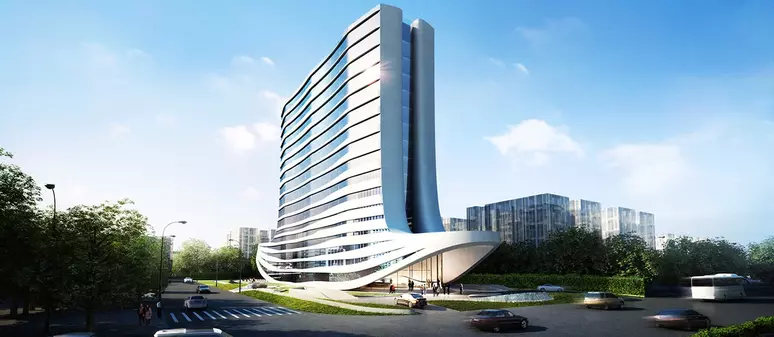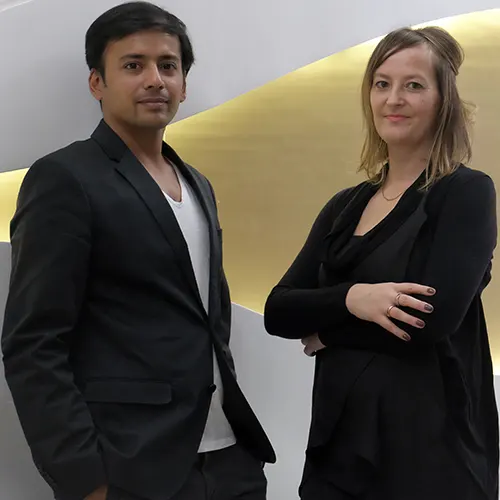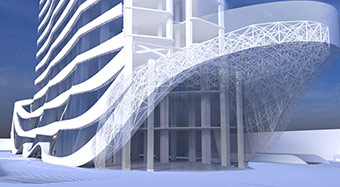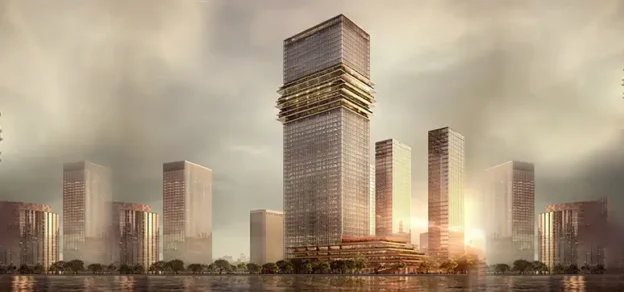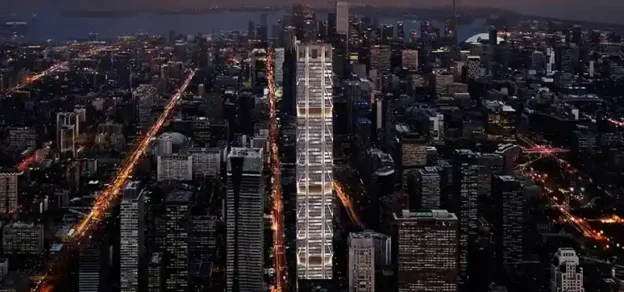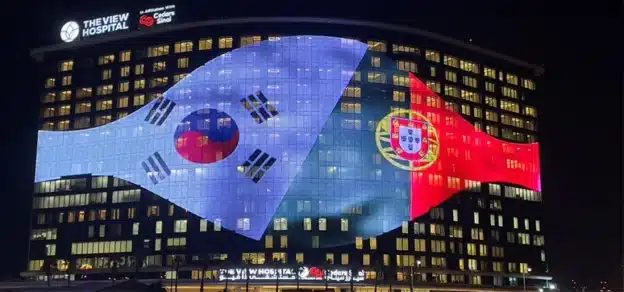An architectural practice with focus on creating spaces that exist in equilibrium with their surroundings, at Studio Symbiosis elements of program, site, context, landscape and climate are studied and interfaced, thereby resulting in the amalgamation of these considerations in one coherent design. Bringing out their aesthetic best, Ar. Amit Gupta and Ar. Britta Knobel Gupta, along with their collaborative partner Ar. Vandana Sehgal designed this upcoming hotel in Ahmedabad which is yet to be titled. The uniqueness of the project comes from its concept where the built harmonizes seamlessly with the surrounding landscape. This is an inherent part of the façade design process whereby a feedback loop is established that constantly updates the formal language of the project thereby embedding environmental sustainability in the form itself.
Design Challenges:
Seamless waves flowing on the landscape and continuing onto the façade were the focal point of the design proposal for this full service five star property. To be designed as an iconic building the proposal looked at interweaving the concept of waves and fold lines as movement trajectories to be perceived along with programmatic requirements.
The idea of creating a design with soft subtle touches and imbibing a sense of elegance was instilled in the proposal from the creation of the form itself.
Key Design Innovations:
A research based collaborative approach was deployed. Real life phenomena such as sun path diagrams, wind patterns, topographical levels, etc.were studied both digitally and physically to instigate a design process resulting in the conceptualizing of the overall form.
The building comprises of three waves which emerge effortlessly from the landscape creating a sense of harmonic relationship with the ground. The profile of the building has been designed with keen emphasis given both to the smooth transition from the horizontal landscape to the vertical building and to the standardization and replication of the façade components.
The façade is designed as an intricate part of the building. The entire façade system feels the reverberation of the slightest of change in the external skin due to flux in the internal spaces. Facade blends from larger areas in the ground to standardized rooms in the upper floors, which in itself is unique typology for the hotels.
Landscape waves
Landscape and façade are designed as an extension of each other in the project, whereby a fuzzy boundary condition is created. The waves of the façade break out into the landscape creating nestled programmatic zones. The landscape acts as a vantage point to immerse the visitor in the architecture of the building and to enjoy the dramatic façade flaring out from it.
Façade waves
The waves in the façade design follow two key principles –
- The internal activity of the building was mapped on the façade and the waves respond to them creating a relationship with the program distribution. A gradient in the thickness of the waves has been instilled in the design whereby the waves or the solid aluminium bands recede in height as they move upwards on the building.
The perspective further strengthens this gradient as the bands virtually disappear as they move upwards also giving an unobstructed view from the guest rooms. - The second critical element incorporated in the design is related to the formal expression of the built form itself. The design comprises of three waves on either side of the building. To strengthen the movement of these waves, the solid aluminium responds and reciprocates the same way as in the elevation design whereby the bands become thicker at the crest and thinner at the trough.
Standardization and optimization
The form itself is double-curved in some places and single-curved at others. This complexity of the form was looked at as a design parameter and greatly influenced the façade design. The vertical curvature of the building is broken down by the aluminium bands at each floor. This means that the glass can be faceted vertically and still remain conspicuous without affecting the design concept. The aluminium bands cover the façade line at the slab level at the same time creating a visual illusion of the building still being curved.
Technical roadblocks and applied Interventions:
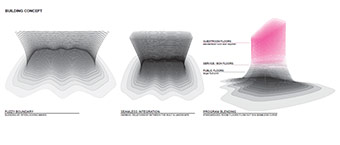
The initial concept was to have the waves built in concrete and then cladding over it. The system to be used was a window wall system. But then the façade consultant on board explained the disadvantages of the same:
- Each joint on each floor between the wall and glass was a possible point of leakage considering the tolerances in Indian buildings. There are always gaps left between the façade and wall which are filled with silicone which gives away in due course of time and we get water leakages.
- The second disadvantage was the time factor. Window wall takes more time to produce and it has to be executed at the site. So the quality is poor.
- The third disadvantage was the concrete wall inside was taking away the usable floor space. So a unitized system was proposed.
But every solution comes with a technical challenge. Here it was the non-uniformity of the panel size because of the geometry of the building. The building had more than 60 different panel sizes which was a major hindrance in going for unitized panels. Simulations were carried out the variety of panel sizes was reduced to 4 with 95 % being of the same size. The major advantage of going with unitized was that a primary continuous skin which is air and water tight could be realized.
But now the second challenge was to put the elevation feature over the façade. It had to be lightweight since it was directly loaded on the unitized primary façade below. Hence the light-weight aluminium panels were used.
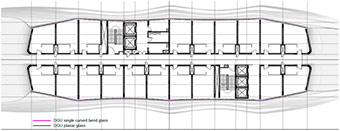
Another problem with the project is the geometry of the lower floors. To tackle that all the drawings were made in 3D and production drawings are derived from the same. Hence, site measurement is ruled out thus limiting the scope of human error. The façade will be produced and installed at the site which will accommodate the tolerances of the civil structure.
Façade Highlights:
- Orientation of the façade – East-West
- Façade Material– Unitized System + Glass + Aluform Aluminium Sheets
- System used – Schueco Troptec System
- Type of glass – High-performance double silver Low E coating with high selectivity
- Coating on the cladding – High Gloss PVDF sparkling white.
- Joinery – Open Groove system
- Hardware used– No special hardware
- Structural/wind load requirement expected from the façade – 2.4 KPA
- Façade testing done if any – No
Quick Facts:
Architects:
Studio Symbiosis www.studio-symbiosis.com
Partners: Amit Gupta, Britta Knobel Gupta, Dr. VandanaSehgal (Hon.)
Project Architect: M. Shaique Uddin
Project Team: Viraat Kumar, Laura B. Robin, Joy Mondal, AhefazPanjwani, MariiaNazarenko, Rishi Sapra, Rakesh Mathur, PanchamPathania, MayankOjha, Avishek Das and Arunima Sen.
Structural Consultant: Acecon Engineers Pvt. Ltd.
Canopy Structural Consultant: Jaitly Associate
Facility Managers: HPG Consultancy
Facade Consultants: Priedemann Fassadenberatung GmbH
MEP: Apostle Design Studio
Security: Mahindra Special Services Group
FLS: Fyrprotek
Site area: 6603sq. mt.
Built-up Area: 24000 sq. mt.
Start Date: April 2012
Completion Date: June 2015
